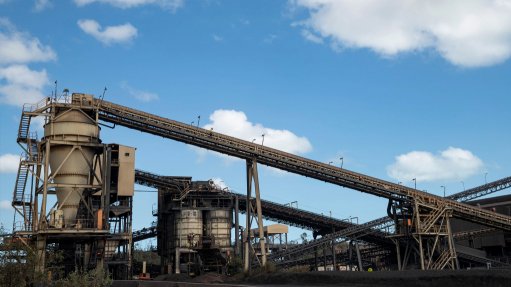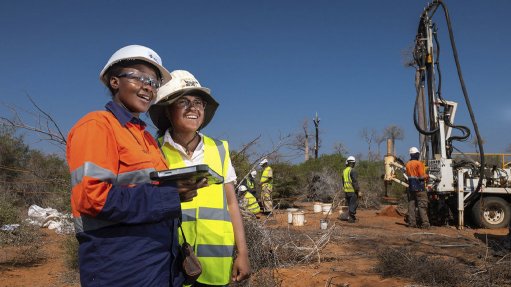Tracking system reduces conveyor misalignment

ALIGNING CONVEYOR BELTS Martin Engineering’s tracker system continuously corrects misaligned conveyor belts
RESULTS OF MISALIGNED BELTS A misaligned belt can quickly drift into the conveyor frame and begin abrading the belt and the structure
Bulk materials handling solutions provider Martin Engineering offers a series of responsive conveyor belt tracking systems that mitigate misalignment, rather than correcting it after the fact – even on reversing belts – to promote conveyor efficiency and safety.
A mistracking belt can come into contact with the main frame, seriously damaging both the belt and the structure, resulting in excessive spillage and even creating a potential fire hazard.
Using innovative multiple-pivot, torque-multiplying technology, the Martin Tracker detects slight misalignments initiated by unbalanced loads and fouled rollers, using the force of the belt to immediately adjust its position and to realign the path. The trackers reduce risk and material loss, decreasing downtime and operating costs by reducing equipment damage and cleanup.
Rollers attached to the end of a sensing arm assembly ride both sides of the belt edge, detecting even slight variations in the belt path. Employing the force of the wandering belt, the arms automatically position a steering idler in the opposite direction of the misalignment. Transferring the motion to the steering idler through a unique parallel linkage requires less force to initiate the correction, so fine-tuning of the path can be continuous, active and precise.
Martin Engineering product engineer Dan Marshall says the biggest issue regarding a mistracking belt is spillage. “If the belt is out of place, it is not handling the load properly, which will cause material to leave the belt. The build-up can be extremely rapid, especially from a high-speed conveyor, which drives up expenses owing to wasted material and added cleanup. It also introduces the inherent risk that is always present when people are working around a moving conveyor,” he says.
Marshall adds that the other big issue is having an instantaneously responsive tracking system, as a misaligned belt can quickly drift into the conveyor frame and begin abrading the belt and the structure. “If this is not caught right away, great lengths of valuable belting can be destroyed and the structural steel itself can be damaged. In some cases, this has caused fires or compromised the integrity of the structure.”
The multipivot design of the Martin system corrects many of the problems exhibited by trainer systems currently on the market, such as belt switches, vertical guildes, v-idlers, crowned pulleys and sensing-roll trainers. Some correction systems have a tendency to overcompensate, requiring a safety tether or lead line to catch the device when the force of the misalignment detaches the unit from the mainframe. Many of these systems correct mistracking after it has occurred, rather than constantly working to prevent it. However, by continuously mitigating tracking issues rather than reacting to them, the risk of failure is significantly reduced.
Using a troughed idler support system on the carrying side of the conveyor to retain the proper angle and keep the load centred, Martin Engineering’s belt tracker upper unit employs guide rolls that are set 6 mm from the belt – for high precision when making opposing adjustments to the idlers.
Typically positioned shortly after the loading zone and just before the discharge pulley, extra trackers can be placed along the belt path, depending on the length of the conveyor and the tendency for cargo to shift. Belt tracker lower units are hung from the main frame under the return belt every 21 m to 50 m and use a single flat rubber idler to bring the belt back into alignment.
Upper and lower trackers are available in three models: standard duty, heavy duty (HD) and extra heavy duty (XHD). The standard-duty model is designed for typical industrial materials handling conditions, and can accommodate belt thicknesses of 16 mm and under, widths from 500 mm to 1 600 mm and speeds of up to 3.5 m/s.
Engineered to withstand the stress associated with wider, thicker belts moving at higher speeds and carrying heavier loads, the HD tracker serves belts as thick as 28.5 mm and widths of 800 mm to 2 000 mm, travelling as fast as 4 m/s. The tracker XHD handles all other belt speeds and thicknesses exceeding those specifications for belts of up to 2 700 mm in width.
Reversing belts are a particularly difficult issue for belt tracking. “Reversing belts have some unique issues, because what works for conventional belt-training devices to centralise a belt’s path when it runs in one direction, will have the opposite effect when the belt direction is reversed,” notes Marshall.
He adds that a pivoted idler that correctly steers the belt when the conveyor is operating in one direction will mistrack a belt moving in the opposite direction.
Martin Engineering designers determined that the same multiple-pivot, torque-multiplying technology as the upper and lower tracker could be used for a reversing belt by adding a cir- cular forked paddle or stainless steel lamella that detects the belt direction. Using two sets of sensing arm assemblies on either side of the unit to accommodate belt widths of 500 mm to 2 200 mm, the arms are engaged based on the direction of the spinning paddle.
Martin Engineering’s tracker reversing belt is also available with an air-operated cylinder that replaces the paddle wheel to activate the sensing rollers on the proper end of the unit when the belt direction changes. To keep the belt centred in a reversing conveyor’s loading zones, Martin Engineering recommends the installation of one reversing tracker at the entry and exit of each loading point.
“Although reducing downtime and operating costs are at the top of our minds with these designs, safety is a primary motivating factor behind all of our components.
“By incorporating that philosophy into the tracker reversing belt designs, we’ve produced a better end product that delivers a complete solution to mistracking issues.”
Comments
Announcements
What's On
Subscribe to improve your user experience...
Option 1 (equivalent of R125 a month):
Receive a weekly copy of Creamer Media's Engineering News & Mining Weekly magazine
(print copy for those in South Africa and e-magazine for those outside of South Africa)
Receive daily email newsletters
Access to full search results
Access archive of magazine back copies
Access to Projects in Progress
Access to ONE Research Report of your choice in PDF format
Option 2 (equivalent of R375 a month):
All benefits from Option 1
PLUS
Access to Creamer Media's Research Channel Africa for ALL Research Reports, in PDF format, on various industrial and mining sectors
including Electricity; Water; Energy Transition; Hydrogen; Roads, Rail and Ports; Coal; Gold; Platinum; Battery Metals; etc.
Already a subscriber?
Forgotten your password?
Receive weekly copy of Creamer Media's Engineering News & Mining Weekly magazine (print copy for those in South Africa and e-magazine for those outside of South Africa)
➕
Recieve daily email newsletters
➕
Access to full search results
➕
Access archive of magazine back copies
➕
Access to Projects in Progress
➕
Access to ONE Research Report of your choice in PDF format
RESEARCH CHANNEL AFRICA
R4500 (equivalent of R375 a month)
SUBSCRIBEAll benefits from Option 1
➕
Access to Creamer Media's Research Channel Africa for ALL Research Reports on various industrial and mining sectors, in PDF format, including on:
Electricity
➕
Water
➕
Energy Transition
➕
Hydrogen
➕
Roads, Rail and Ports
➕
Coal
➕
Gold
➕
Platinum
➕
Battery Metals
➕
etc.
Receive all benefits from Option 1 or Option 2 delivered to numerous people at your company
➕
Multiple User names and Passwords for simultaneous log-ins
➕
Intranet integration access to all in your organisation


















